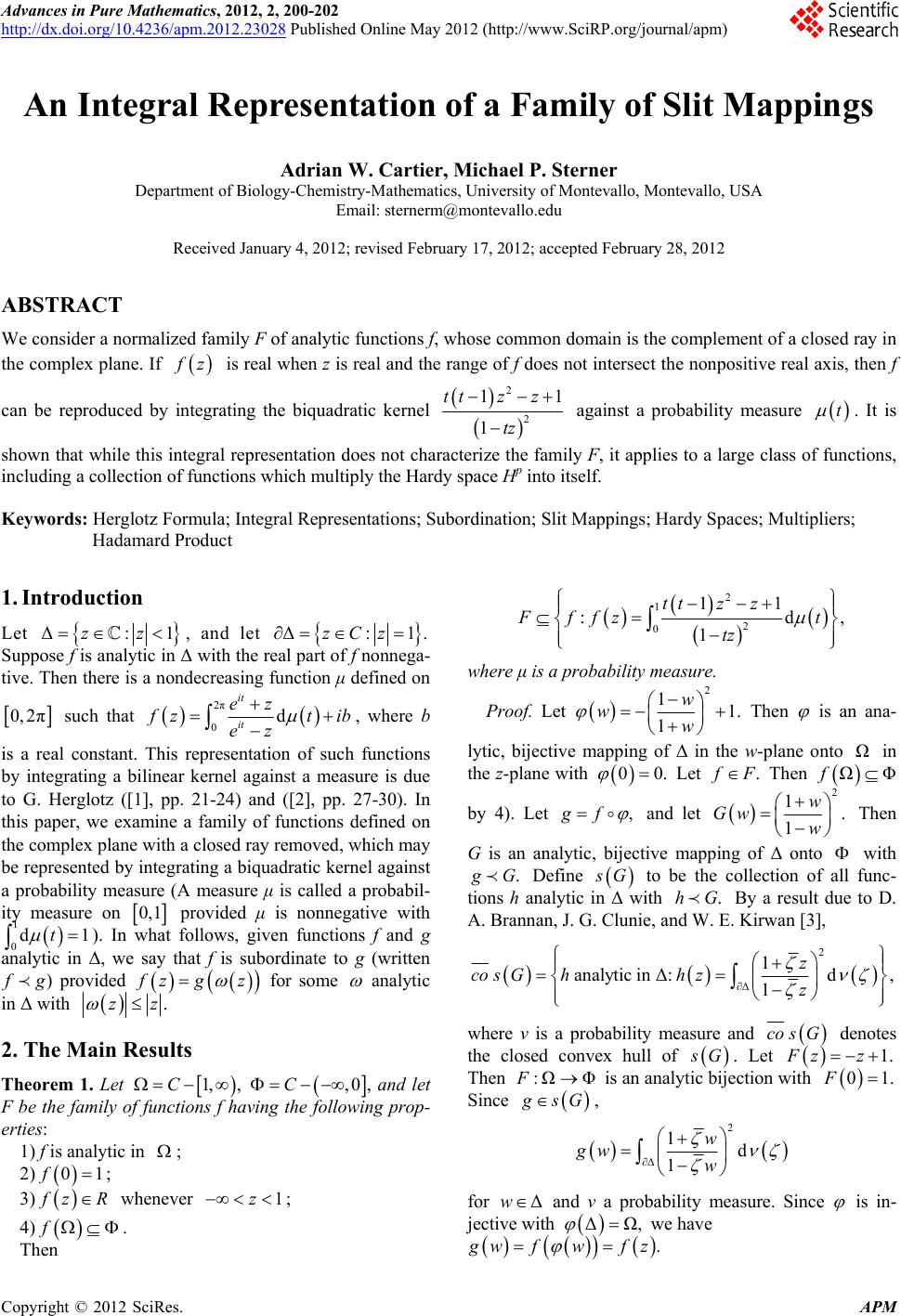
Advances in Pure Mathematics, 2012, 2, 200-202
http://dx.doi.org/10.4236/apm.2012.23028 Published Online May 2012 (http://www.SciRP.org/journal/apm)
An Integral Representation of a Family of Slit Mappings
Adrian W. Cartier, Michael P. Sterner
Department of Biology-Chemistry-Mathematics, University of Montevallo, Montevallo, USA
Email: sternerm@montevallo.edu
Received January 4, 2012; revised February 17, 2012; accepted February 28, 2012
ABSTRACT
We consider a normalized family F of analytic functions f, whose common domain is the complement of a closed ray in
the complex plane. If
z is real when z is real and the range of f does not intersect the nonpositive real axis, then f
can be reproduced by integrating the biquadratic kernel
2
2
11
1
z z
tz
tt
against a probability measure
t
. It is
shown that while this integral representation does not characterize the family F, it applies to a large class of functions,
including a collection of functions which multiply the Hardy space Hp into itself.
Keywords: Herglotz Formula; Integral Representations; Subordination; Slit Mappings; Hardy Spaces; Multipliers;
Hadamard Product
1. Introduction
Let
:z
1zΔ, and let
:1.zCz
Δ
Suppose f is analytic in Δ with the real part of f nonnega-
tive. Then there is a nondecreasing function μ defined on
0, 2π
such that
d
ez
2π
0
it
it
z
tib
ez
, where b
is a real constant. This representation of such functions
by integrating a bilinear kernel against a measure is due
to G. Herglotz ([1], pp. 21-24) and ([2], pp. 27-30). In
this paper, we examine a family of functions defined on
the complex plane with a closed ray removed, which may
be represented by integrating a biquadratic kernel against
a probability measure (A measure μ is called a probabil-
ity measure on
0, 1
11
provided μ is nonnegative with
0). In what follows, given functions f and g
analytic in Δ, we say that f is subordinate to g (written
dt
g) provided
zg
z
for some
analytic
in Δ with
.
zz
2. The Main Results
Theorem 1. Let ,
1,C
,0C
01f
, and let
F be the family of functions f having the following prop-
erties:
1) f is analytic in ;
2) ;
3)
z1z
f
R
whenever ;
4) .
Then
2
1
2
0
11
:d,
1
ttz z
ffz t
tz
where μ is a probability measure.
Proof. Let
2
11.
1
w
ww
Then
is an ana-
lytic, bijective mapping of Δ in the w-plane onto in
the z-plane with
Ω
00.
Let . Then fF
ΩΦf
,
gf
by 4). Let
and let
2
1.
1
w
w
Gw Then
G is an analytic, bijective mapping of Δ onto
with
.G Define G
.hG
to be the collection of all func-
tions h analytic in Δ with By a result due to D.
A. Brannan, J. G. Clunie, and W. E. Kirwan [3],
2
Δ
1
analytic inΔ:d
1
z
co sGhhzz
,
where v is a probability measure and
co sG
denotes
the closed convex hull of G
1.Fz z. Let
:ΩΦF
Then is an analytic bijection with
01.F
Since
sG
,
2
Δ
1d
1
w
gw w
Δw
and v a probability measure. Since for
is in-
jective with
ΔΩ,
we have
wf wfz
.
C
opyright © 2012 SciRes. APM